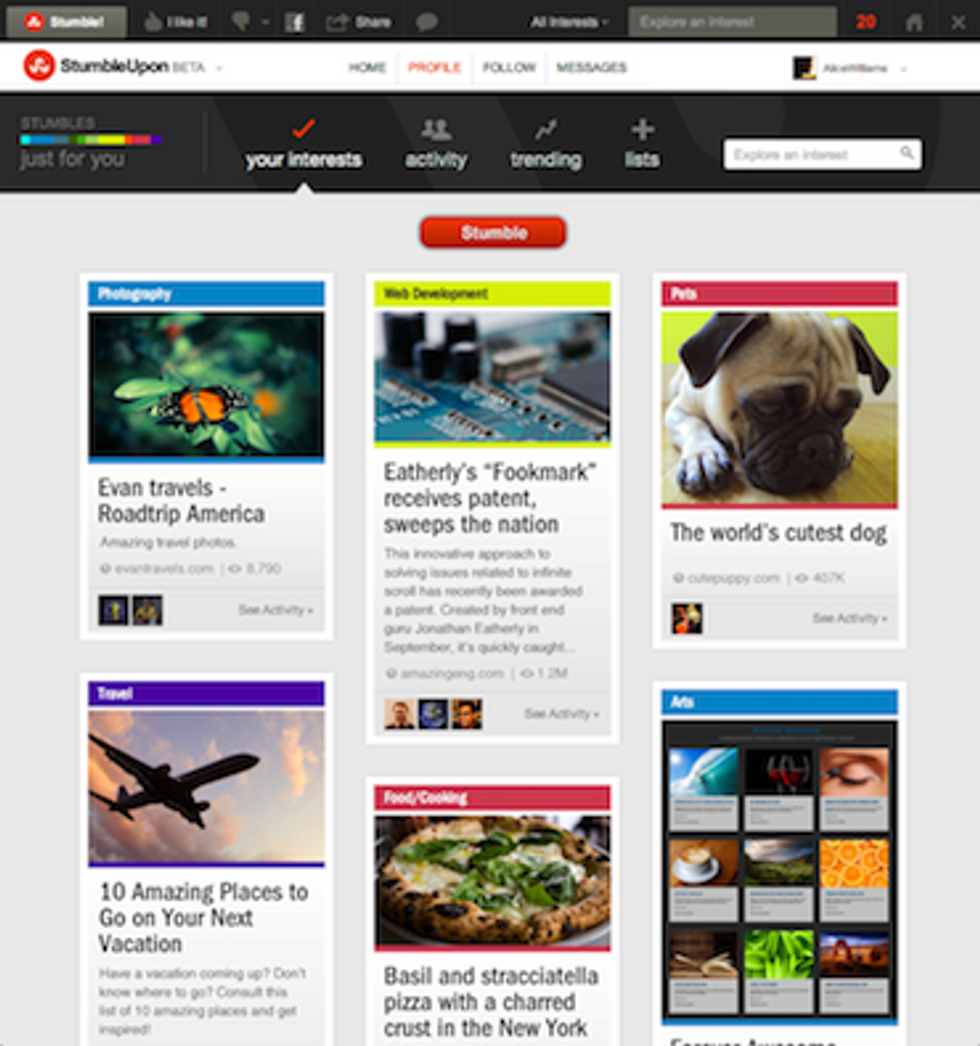It’s been a busy year over at what is arguably the web’s top discovery engine, StumbleUpon.
From its offices in SoMA, the company has relaunched its website, plus apps for the iPhone and iPad, and most recently a new version of its product for Windows 8, for tablets and PCs.
Helping to drive this wave of activity is the company’s new VP of Product, Cody Simms, who left a senior position at Yahoo to join SU earlier this year.
Simms says the company’s current product strategy rests on three main “pillars.”
“The first is rethinking identity,” he told me. “Your identity on StumbleUpon is based on what you like. That’s how you represent yourself to our community.
“Part of that identity is your Stumble DNA – we group the sites you like into categories by color.”
Now, this is the kind of data-driven visualization geeks like me love. I counted fourteen colors that express the SU taxonomy at a high level, fanning out to more than 500 sub-categories below.
You could think of this as your intellectual digital fingerprint based on the various types of content you like the most, which is something SU provides based on your thumbs-up votes and other indicators.
The second pillar to SU’s product strategy is giving users new ways to stumble, i.e., discover great new content.
“The classic way was that you gave us your interests and we served up content that other people with those interests like,” Simms said. “Now we have enabled users to create and share ‘lists’.”
This works, IMHO, because we have entered the age of curation. The web has exploded to the point where the problem for most of us is not how to find content, but how to find the signal in the noise.
SU is turning its large user base into curators able to share their favorite stuff in lists.
Another part of this bucket of functionality is “trending,” which allows users to see whole-site data that captures what is trending across SU as a whole.
Borrowed, of course, from Twitter, this is again a feature that really appeals to data heads, journalists, and news junkies.
Another recent add is “activity” – content recommended by people you know or experts in the field, and essentially tracks social activity like thumbs ups, comments, postings to Facebook, Twitter, etc.
Finally, we come to the third pillar of the company’s product strategy, and that is to improve the moment of discovery based on where you are at that particular moment in your day and week.
So, SU might serve you dinner recipes when you are home at 6 pm, as opposed to tech news when you hit the office at 9 am.
“The right content for you depends on the time of day, the day of week, where you are and what device you are using,” notes Simms.
Like virtually every company I visit, SU is seeing a massive upsurge in mobile traffic, which now accounts for upwards of 25 percent of its traffic.
StumbleUpon has a successful model for monetizing its content.
“We have a very successful advertising platform,” Simms said. “It is paid discovery, and more than 75,000 products and brands have tried it for ad campaigns.”
A recent example was Red Bull’s sponsorship of Felix Baumgartner's jump through the stratosphere.
“When companies advertise on StumbleUpon,“ noted Simms, “there are no ad units, no banners, no impressions. It’s just pure traffic back to their sites. Their money drives visitors to a site that people like when they discover it. It's called Native Advertising.”
The best part of that, from my perspective, is this:
“Their sponsored content only stays up there on our site if our users thumb it up. If they thumb it down, it goes away.”
I cannot imagine a more valuable type of feedback for brands and advertisers. If consumers like your content, you will get lots of valuable traffic.
If your content sucks, you’re well advised to let that particular campaign die.





















